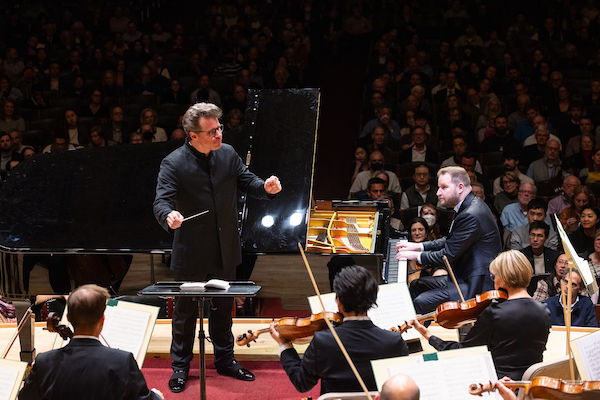Concert Review: Jakub Hrůša and the Bamberg Symphony Orchestra — An Admirable Balancing Act
By Arron Keebaugh
The Bamberg Symphony Orchestra is a rare gem in the already star-studded crown of European ensembles.

Jakub Hrůša conducting the Bamberg Symphony Orchestra and pianist Lukáš Vondráček in a performance of Robert Schumann’s Piano Concerto. Photo: Robert Torres/Celebrity Series
Conductor Jakub Hrůša has always been about spectacle — visual as well as musical. When he first came to Boston in 2016, his performance with the Boston Symphony Orchestra of Leoš Janáček’s Taras Bulba mesmerized through his aggressive downbeats, sweeping waves of the hand, and the occasional leaping cutoff. If memory serves, the music flashed and flickered, with the inner lines charging forward with rapt intensity generated by the musicians’ grand climactic sweep.
Eight years on, Hrůša has retained that captivating flair, albeit with some freshly mature poise and sensitivity. With the Bamberg Symphony Orchestra, an ensemble he has led since 2016, the Czech conductor routinely paints musical pictures infused with vivid details and flourishing strokes. Under his guidance, wind and string phrases rise out of the texture, coil in delicate shapes, and fade with breathless ease. His performances can still send shockwaves through the spine, but they do so through the slow buildup of tension.
That was the explosive virtue Hrůša brought to works by Brahms, Schumann, and Wagner when he led the Bamberg Symphony Orchestra in their long-awaited return to the Celebrity Series last week at Symphony Hall.
The Bambergers are a rare gem in the already star-studded crown of European ensembles. Founded in the small Bavarian town by German musicians who were expelled from Czechoslovakia just after World War II, the orchestra steadily rose to international renown during the late 20th century. (They last came to Boston in 1983). Herbert Blomstedt, Christoph Eschenbach, and Manfred Honeck have been regular guest conductors — each were named honorary conductors in 2006, 2016, and 2023 respectively. The orchestra has undertaken unusual projects for their recordings, including the symphonic poems by Karl Goldmark and the symphonies of Max Bruch and Alexander Glazunov. Hrůša himself led the Bamberg Symphony in a recording of Hans Rott’s Symphony No. 1, a rendition memorable in its power and serenity.
Even when he focuses on standard repertoire, Hrůša searches for — and often finds — surprising vitality. Last week’s performance of Brahms’s Symphony No. 3 had everything a listener could ask for: a deft balance between winds and strings as well as a keen attention to the dramatic highs and lows that paid off in the final hymnic gestures.
But what made this reading one of the finest of the season was the natural ease with which Hrůša drew out the music’s wistful lyricism and surging ecstasies. The opening statements blazed with a fiery panache that was smoothed into the graceful themes that followed. Still, even there, Hrůša kept spurts of energy roiling just beneath the surface. That allowed for the second movement, usually rendered with reverence, to cast various shades of light and darkness — and even generate some fleeting joy.
Hrůša has a way of teasing out the details without drawing undue attention to them. Winds and strings never upstaged one another in the third movement’s waltz, which the conductor shaped with broad tempos and varied washes of color. At times, one sensed that Hrusa wasn’t interested in taking too many risks. But the finale, put across with vigorous intensity, quickly dismissed those thoughts. On the whole, this was a Brahms that unfolded in multiple dimensions, where waters were churning in the deep, despite a beguiling calm on the surface.

Jakub Hrůša conducting the Bamberg Symphony Orchestra and pianist Lukáš Vondráček in a performance of Robert Schumann’s Piano Concerto. Photo: Robert Torres/Celebrity Series
By contrast, Robert Schumann’s Piano Concerto betrayed uncharacteristic delicacy.
The soloist was Lukáš Vondráček, who treated the rippling arpeggios with Mozartean finesse. For the most part, the approach worked. It is true that Schumann’s concerto calls for a lighter touch than it usually gets, particularly in the passages where wind and string solos frame the piano filigree. Still, there were moments in this performance when one wanted a little more weight. The octave figures of the opening movement moved with lithesome finesse, but they felt understated. Later in the movement, however, Vondráček and Hrůša found the requisite zeal when those themes returned.
The rest of the performance offered little that was unexpected, aside from its sparkling delights. The second movement embodied searching intimacy; the finale coursed with bucolic vitality. All the while, Vondráček’s performance danced with athletic prowess, though it was less a hero’s journey than a communal quest in which everyone plays a significant role. In that spirit, Hrůša drew an accompaniment finely attuned to the soloist’s poise and restraint. Vondráček rewarded the applause with an encore of Schumann’s Arabesque that channeled greater tempestuousness.
Music by Richard Wagner bookended the concert. The Prelude to Lohengrin emerged as if it were a figure creeping out of the shadows. Hrůša treated the music’s lines with breathy attacks that kindled a distant glow. When the horns and woodwinds stepped into the light, he shaped every melodic curve with a sculptor’s eye for detail. The overture to Tannhäuser, particular the “Pilgrim’s Chorus,” counterbalanced sensitivity with serenity.
While Hrůša expertly conveyed all those swirling mists and haunting mysteries, he didn’t stop there. Two encores — Brahms’s Hungarian Dances Nos. 18 and 21 — revealed that the young conductor and his lucid band are just as capable of partying hard.
Aaron Keebaugh has been a classical music critic in Boston since 2012. His work has been featured in the Musical Times, Corymbus, Boston Classical Review, Early Music America, and BBC Radio 3. A musicologist, he teaches at North Shore Community College in both Danvers and Lynn.

